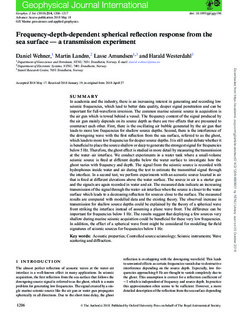| dc.contributor.author | Wehner, Daniel | |
| dc.contributor.author | Landrø, Martin | |
| dc.contributor.author | Amundsen, Lasse | |
| dc.contributor.author | Westerdahl, Harald | |
| dc.date.accessioned | 2018-10-05T12:48:45Z | |
| dc.date.available | 2018-10-05T12:48:45Z | |
| dc.date.created | 2018-09-21T08:41:24Z | |
| dc.date.issued | 2018 | |
| dc.identifier.issn | 0956-540X | |
| dc.identifier.uri | http://hdl.handle.net/11250/2566695 | |
| dc.description.abstract | In academia and the industry, there is an increasing interest in generating and recording low seismic frequencies, which lead to better data quality, deeper signal penetration and can be important for full-waveform inversion. The common marine seismic source in acquisition is the air gun which is towed behind a vessel. The frequency content of the signal produced by the air gun mainly depends on its source depth as there are two effects that are presumed to counteract each other. First, there is the oscillating air bubble generated by the air gun that leads to more low frequencies for shallow source depths. Second, there is the interference of the downgoing wave with the first reflection from the sea surface, referred to as the ghost, which leads to more low frequencies for deeper source depths. It is still under debate whether it is beneficial to place the source shallow or deep to generate the strongest signal for frequencies below 5 Hz. Therefore, the ghost effect is studied in more detail by measuring the transmission at the water–air interface. We conduct experiments in a water tank where a small-volume seismic source is fired at different depths below the water surface to investigate how the ghost varies with frequency and depth. The signal from the seismic source is recorded with hydrophones inside water and air during the test to estimate the transmitted signal through the interface. In a second test, we perform experiments with an acoustic source located in air that is fired at different elevations above the water surface. The source in air is a starter gun and the signals are again recorded in water and air. The measured data indicate an increasing transmission of the signal through the water–air interface when the source is closer to the water surface which leads to a decreasing reflection for sources close to the surface. The measured results are compared with modelled data and the existing theory. The observed increase in transmission for shallow source depths could be explained by the theory of a spherical wave front striking the interface instead of assuming a plane wave front. The difference can be important for frequencies below 1 Hz. The results suggest that deploying a few sources very shallow during marine seismic acquisition could be beneficial for these very low frequencies. In addition, the effect of a spherical wave front might be considered for modelling far-field signatures of seismic sources for frequencies below 1 Hz. | nb_NO |
| dc.language.iso | eng | nb_NO |
| dc.publisher | Oxford University Press (OUP) | nb_NO |
| dc.title | Frequency-depth-dependent spherical reflection response from the sea surface - a transmission experiment | nb_NO |
| dc.title.alternative | Frequency-depth-dependent spherical reflection response from the sea surface - a transmission experiment | nb_NO |
| dc.type | Journal article | nb_NO |
| dc.type | Peer reviewed | nb_NO |
| dc.description.version | publishedVersion | nb_NO |
| dc.source.volume | 214 | nb_NO |
| dc.source.journal | Geophysical Journal International | nb_NO |
| dc.source.issue | 2 | nb_NO |
| dc.identifier.doi | 10.1093/gji/ggy196 | |
| dc.identifier.cristin | 1611830 | |
| dc.relation.project | Norges forskningsråd: 228400 | nb_NO |
| dc.relation.project | EU/641943 | nb_NO |
| dc.description.localcode | © The Author(s) 2018. Published by Oxford University Press on behalf of The Royal Astronomical Society. This article is published and distributed under the terms of the Oxford University Press, Standard Journals Publication Model (https://academic.oup.com/journals/pages/about_us/legal/notices) | nb_NO |
| cristin.unitcode | 194,64,90,0 | |
| cristin.unitcode | 194,63,35,0 | |
| cristin.unitname | Institutt for geovitenskap og petroleum | |
| cristin.unitname | Institutt for elektroniske systemer | |
| cristin.ispublished | true | |
| cristin.fulltext | preprint | |
| cristin.qualitycode | 2 | |
